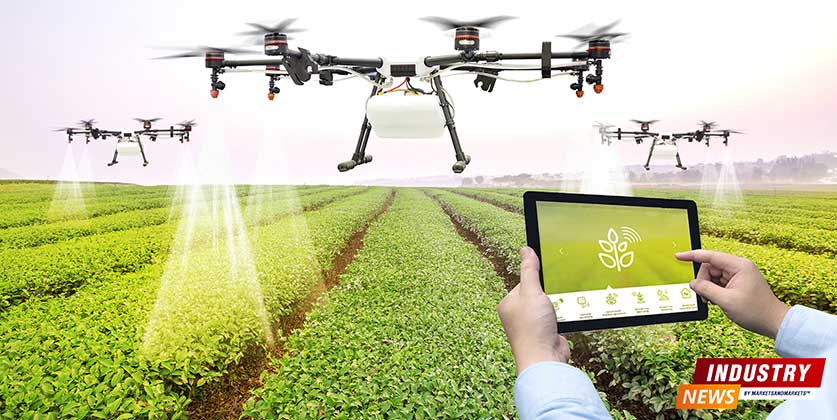Google's Project Mineral in 2023:Revolutionizing Agriculture with AI

This News Covers
- Generative AI Adoption in Agriculture Industry & Top Use Cases
- What are Some of the Generative AI Courses?
- Which Top Countries are Witnessing Adoption of AI in Agriculture Industry?
Google's Project Mineral, an initiative under Alphabet, has been making strides in the field of computational agriculture, a subset of which is AI in agriculture. The project, which spun out as an independent company in early 2023, aims to create a more sustainable, climate-resilient, and productive food system. It uses machine learning and other AI technologies to improve farming practices and sustainability.
Recent developments in the second quarter of 2023 indicate a growing interest and investment in AI in agriculture. The AI in Agriculture Market is projected to grow from USD 1.7 billion in 2023 to USD 4.7 billion in 2028; it is expected to grow at a CAGR of 23.1% from 2023 to 2028 as indicated by MarketsandMarkets.
This growth is likely driven by the increasing need for food security, climate change challenges, and the benefits of predictive analytics in agriculture.
Google's Project Mineral, as a part of this growing market, is likely contributing to these developments. However, it's important to critically assess the impact and scalability of such initiatives. While AI can provide valuable insights and optimizations, its effectiveness is dependent on data quality, and its adoption can be hindered by factors such as high implementation costs, lack of digital literacy among farmers, and data privacy concerns. Therefore, for Google's initiatives to be truly impactful, these challenges need to be addressed.
Impact of Generative AI in the Agriculture Industry
Generative AI models can learn from vast datasets, including weather patterns, soil conditions, and crop health data, to predict future outcomes accurately. These insights can help farmers make informed decisions, leading to increased crop yields and profitability.
Precision farming, made possible through generative AI, allows farmers to manage their fields on a micro-scale, maximizing efficiency and reducing waste. This approach can lead to cost savings, improved yields, and minimal environmental impact.
Generative AI in agriculture isn't confined to the fields. It also optimizes supply chains, creating models that predict demand and supply, helping reduce wastage and improving market responsiveness.
AI algorithms can predict the genetic combinations that would result in desired crop traits, accelerating the breeding process, and ultimately leading to more resilient, high-yielding crop varieties.
Generative AI can provide personalized advice to farmers in all stages of crop management. Farmers can provide details about their questions, and the system can provide contextual advisory. This can help bridge the gap in the market around farmers’ awareness of newer techniques and farming in alignment with changes in nature – water, soil, and market requirements of production.
Generative AI can be trained on government scheme data to answer a farmer or any consumer about their eligibility for different schemes. This can help farmers get the assistance they need more efficiently.
By using voice-based ML and summarizing calls, one can monitor and categorize the daily calls coming to the call center automatically into the type of issues faced by farmers. This can help provide better service to farmers by various agriculture departments.
- Predictive Analytics:
- Precision Agriculture:
- Supply Chain Optimization:
- Crop Breeding:
- Personalized Advisory to Farmers:
- Eligibility for Schemes:
- Monitoring Problems Faced by Farmers:
- Personalized Training in Agriculture:
Generative AI can act as a personalized tutor to the specific question a farmer asks. This can help farmers learn about new farming techniques, understand good agriculture practices, and make informed decisions about changing crops.
What is Computational Agriculture and its Relationship with AI in Agriculture?
Computational agriculture is a field of study that applies computational methods, principles, and algorithms to solve problems in agriculture. It involves the use of computer science techniques and tools to model, simulate, and analyze agricultural systems. This can include everything from modeling crop growth and predicting yield to optimizing resource use and managing risks in agricultural production.
Artificial Intelligence (AI) in agriculture refers to the application of AI technologies, such as machine learning, computer vision, and predictive analytics, specifically in the field of agriculture. AI can be used to analyze data from farm fields and use predictive analytics to make informed decisions. This can help farmers optimize their operations, improve crop yields, reduce waste, and increase efficiency.
- Computational Agriculture:
- AI in Agriculture:
While both computational agriculture and AI in agriculture involve the use of technology to improve agricultural practices, they are not the same thing. Computational agriculture is a broader field that encompasses a wide range of computational techniques and applications in agriculture, while AI in agriculture is a subset of computational agriculture that specifically focuses on the use of AI technologies.
In other words, AI in agriculture is a part of computational agriculture. All AI applications in agriculture can be considered as computational agriculture, but not all computational agriculture involves AI. For example, simple statistical models or optimization algorithms used in agriculture would fall under computational agriculture but may not involve any AI.
Top Generative AI Research in Agriculture
This is one of the leading early-stage agricultural companies in the world. They use artificial intelligence (AI) for fruit counting. Their algorithm for fruit counting was trained with over 11 varieties of blueberries, which recognizes different phenological stages of the blueberry (flower, green, purple, and blue). With this recognition and counting, harvest projections are made for further weeks, allowing the farmer to have a more accurate forecast of up to a 92% [1. source: Forbes].
The EU is investing in AI and machine learning to improve agricultural practices. They are using AI to optimize irrigation, detect diseases in crops, and predict weather patterns. The EU is also using AI to create digital twins of farms, which can help farmers make better decisions about crop rotation, fertilization, and pest control [2. source: European Parliamentary Research Service].
The IARI is using AI to predict crop yields and detect diseases in crops. They are also using AI to optimize irrigation and fertilization [3. source: Analytics India Magazine].
Microsoft's FarmBeats project is using AI and IoT to help farmers monitor soil moisture levels, predict weather patterns, and optimize irrigation. They are also using AI to predict crop yields and detect diseases in crops.
IBM's Watson Decision Platform for Agriculture uses AI to help farmers make better decisions about crop management. The platform uses AI to analyze weather data, satellite imagery, and IoT sensor data to provide farmers with actionable insights.
- SpaceAG:
- The European Union (EU):
- Indian Agricultural Research Institute (IARI):
- Microsoft:
- IBM:
Generative AI Adoption in Agriculture Industry & Top Use Cases
Generative AI is used for enhanced crop management. By analyzing vast amounts of data, including satellite imagery, weather data, and soil composition, generative AI algorithms can identify patterns and trends that help farmers make more informed decisions about when and where to plant, irrigate, and harvest their crops. This data-driven approach leads to more efficient and targeted farming practices, reducing the time and resources required to grow and harvest crops, and ensuring that farmers can maximize their yields while minimizing waste and environmental impact.
Generative AI plays a pivotal role in crop optimization, helping farmers identify the most suitable crop varieties and cultivation techniques for their specific needs and conditions. By analyzing data from a wide range of sources, including historical yield data, climate models, and genetic information, generative AI can create models and simulations that guide farmers in selecting the best crops and practices for their farms. This leads to significant improvements in crop yields and overall agricultural productivity.
Generative AI promotes sustainable farming practices, helping farmers optimize their use of resources such as water, fertilizers, and pesticides. By analyzing data on soil composition, weather conditions, and crop health, generative AI can recommend targeted and precise application of these resources, ensuring that crops receive the nutrients and protection they need without wasteful over-application. This leads to significant cost savings and improvements in overall resource efficiency, as well as reduced environmental impact and increased long-term sustainability for the agriculture industry.
Generative AI enhances pest control strategies by analyzing data on pest populations, weather conditions, and crop health to predict potential outbreaks and recommend targeted interventions. By leveraging AI-driven insights, farmers can proactively address potential pest issues, ensuring that their crops remain healthy and productive while minimizing the need for harmful pesticides and other chemical treatments.
Generative AI enables farmers and agribusinesses to analyze vast amounts of logistical data, identify potential bottlenecks and inefficiencies, and optimize their supply chains accordingly. This leads to significant cost savings and efficiency improvements, ensuring that agricultural products can reach consumers more quickly and affordably.
Generative AI helps farmers adapt to changing conditions by analyzing data on climate trends, soil health, and crop performance to develop more resilient agricultural practices. By identifying potential vulnerabilities and recommending targeted interventions, generative AI can help farmers better prepare for and adapt to the impacts of climate change.
Generative AI plays a critical role in the development of advanced breeding programs, helping researchers and plant breeders identify and develop new crop varieties with enhanced performance, yield potential, and resilience to pests and diseases. By analyzing large-scale genomic data, generative AI can identify the genetic traits associated with desirable characteristics and guide researchers in creating novel crop varieties.
Generative AI revolutionizes the way farmers access information and make decisions about their operations. By developing AI-driven tools and platforms that can analyze and interpret vast amounts of agricultural data, generative AI can provide farmers with actionable insights and recommendations that can help them optimize their practices and improve their bottom line.
- Precision Farming:
- Crop Optimization:
- Resource Management:
- Pest Control:
- Supply Chain Optimization:
- Climate-Resilient Agriculture:
- Advanced Breeding Programs:
- Farmer Education and Decision Support:
The AI in agriculture market is projected to grow from USD 1.7 billion in 2023 to USD 4.7 billion in 2028; it is expected to grow at a CAGR of 23.1% from 2023 to 2028. The adoption of AI in agriculture is not limited to large-scale farming operations. Small and medium-sized farms are also leveraging AI to improve their operations. For instance, in India, the government is actively promoting the use of AI in farming.
What are Some of the Generative AI Courses?
This is an introductory level microlearning course aimed at explaining what Generative AI is, how it is used, and how it differs from traditional machine learning.
Explore online generative AI courses from top universities. Dive into ChatGPT, implications of AI & more as you learn at your own pace & earn certificates.
A recent study by the University of Pennsylvania has studied the implications of Generative AI and professions such as farming.
- Introduction to Generative AI from Coursera:
- Generative AI Courses from FutureLearn:
- Generative AI and its implications for the dairy industry from Connecterra:
Please note that while these courses cover Generative AI, they may not be specifically focused on agriculture. However, the principles and techniques taught in these courses can be applied to a variety of fields, including agriculture. Always check the course syllabus or description to ensure it meets your specific learning goals.
Which Top Countries are Witnessing Adoption of AI in Agriculture Industry?
The United States is one of the leading countries in the adoption of AI in the agriculture industry. The country is home to several startups and established companies that are developing AI-based solutions for agriculture. For instance, Blue River Technology, a US-based company, uses AI and computer vision to make farming more sustainable by reducing the amount of chemicals used in the field.
India, a country where agriculture plays a vital role in the economy, is also witnessing the adoption of AI in its agriculture sector. The Indian government has launched several initiatives. For instance, the government's think tank, NITI Aayog, has proposed the use of AI in crop yield prediction, pest detection, and supply chain management. The Indian startup ecosystem is also vibrant with companies like CropIn and AgNext developing AI-based solutions for agriculture.
China is heavily investing and encouraging the development of AI-enabled products and services in agriculture. Companies such as Deepberry, Chongho Bridge, Beijing Maimai Qugeng Technology provide AI, data science, machine learning services, and AI-powered agricultural equipment. The country is using AI to monitor crops, predict yields, and manage resources more efficiently. For instance, Alibaba Cloud has developed an AI-based system that can predict the growth of crops and provide advice on how to improve yields.
Australia is using AI to tackle the challenges posed by its harsh climate. The country is using AI to predict weather patterns, manage water resources, and monitor crop health. Companies like The Yield, an Australian AgTech company, are using AI to provide farmers with real-time data about their crops.
Brazil, one of the world's largest agricultural producers, is also adopting AI in its agriculture sector. The country is using AI to monitor crops, manage resources, and predict yields. Companies like Strider, a Brazilian AgTech company, are using AI to help farmers manage pests and diseases.
In Peru, companies like SpaceAG are using AI for fruit counting. Their algorithm was trained with over 11 varieties of blueberries, which recognizes different phenological stages of the blueberry. With this recognition and counting, harvest projections are made for further weeks, allowing the farmer to have a more accurate forecast of up to 92%.
- United States:
- India:
- China:
- Australia:
- Brazil:
- Peru:
The use of artificial intelligence (AI) in agriculture extends beyond a few specific countries. Many nations worldwide are embracing AI to enhance agricultural productivity, lower expenses, and promote sustainable farming practices. According to projections, the market for AI in agriculture is set to expand from USD 1.7 billion in 2023 to USD 4.7 billion in 2028, with a compound annual growth rate (CAGR) of 23.1% during that period. This upward trend in AI adoption within the agricultural sector is expected to persist as more countries acknowledge the advantages of leveraging AI to improve productivity and sustainability in their farming practices.
References
GET AHEAD
Top Research Reports to Fuel Your Industry Knowledge- Artificial Intelligence in Agriculture Market by Technology (Machine Learning, Computer Vision, and Predictive Analytics), Offering (Software, AI-as-a-Service), Application (Drone Analytics, Precision Farming) and Region - Global Forecast to 2028
- Digital Agriculture Market Offering, Technology (Peripheral, Core), Operation (Farming & Feeding, Monitoring & Scouting, Marketing & Demand Generation) Type (Hardware, Software, Services), Region - Global Forecast to 2028
- Smart Agriculture Market Size, Share, Statistics and Industry Growth Analysis Report by Offering (Hardware, Software, Services), Agriculture Type, Farm Size (Large, Medium, Small), Application (Precision Farming, Livestock Monitoring) and Region ( America, Europe, Asia Pacific, Row) - Global Forecast to 2028
Editor's Pick


Information and Communication Technology
Insurtech Funding News - Coverdash raises USD 13.5 Million
PODCASTS

Sustainable Digital Transformation & Industry 4.0
Sanjay Kaul, President-Asia Pacific & Japan, Cisco, and host Aashish Mehra, Chief Research Officer, MarketsandMarkets, in conversation on unraveling 'Sustainable Digital Transformation and Industry 4.0'
11 July 2023|S2E12|Listen Now

Generative AI
Prasad Joshi, Senior Vice President-Emerging Technology Solutions, Infosys, and host, Vinod Chikkareddy, CCO, MarketsandMarkets, in exploring the recent advances in AI and the generative AI space.
7 Nov 2023|S2E13|Listen Now
Artificial Intelligence in Agriculture Market
Download Whitepaper
AI algorithms can predict the genetic combinations that would result in desired crop traits, accelerating the breeding process, and ultimately leading to more resilient, high-yielding crop varieties.
The EU is investing in AI and machine learning to improve agricultural practices. They are using AI to optimize irrigation, detect diseases in crops, and predict weather patterns.












